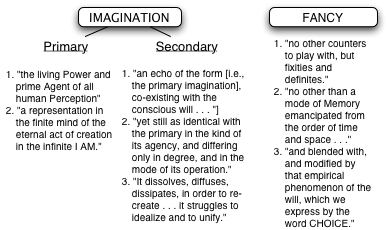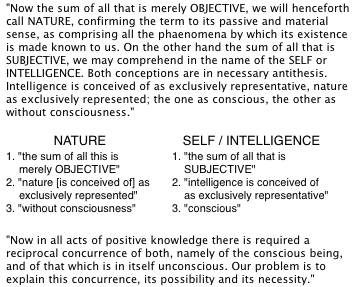Samuel Taylor Coleridge, “On the imagination, or esemplastic power,” Ch. 13 of Biographia Literaria
Bibliographical Notes
- The Biographia Literaria was written in 1815 and first published in July of 1817, when Coleridge was 44. An American edition was published later the same year.
- Thirty years after its initial publication, a second edition was published in 1847 by Coleridge's wife, Sara, 13 years after his death.
- The standard edition is edited by James Engell and W. Jackson Bate, which is Volume 7 of the Collected Works published by Princeton University Press (1983).
Biographical Notes
Reading Notes
-
"esemplastic power" - Coleridge introduces his neologism—esemplastic—at the beginning of Chapter 10:
“Esemplastic. The word is not in Johnson, nor have I met with it elsewhere.” Neither have I! I constructed it myself from the Greek words eis en plattein i.e. to shape into one ….
In their note to Coleridge's explanation, Engell and Bate give this account:
C's coined term “esemplastic” can be traced directly to his front flyleaf note in Maass [J. G. E. Maass's Versuch über die Einbildungskraft (1792; 2nd ed. Halle & Leipzig 1797)]. C is discussing Maass's definition of form as something ab intra and wondering whether the imagination, as a faculty of perception, does not exercise a formative and “external active power” as it experiences the world.…
-
Coleridge's distinctions between “primary” and “secondary” imagination and between “imagination” and “fancy”:

IMAGINATION - Primary
- The primary imagination as "the living Power and prime Agent of all human Perception" is an idea from the first edition of Kant's Kritik der reinen Vernunft (Critique of Pure Reason), published in 1787. In a section entitled "The Pure Concepts of the Understanding, or Categories," Kant claims that the imagination is that faculty of mind which creates experience by combining, or synthesizing the discrete elements of sensuous data.
-
Coleridge introduces the concept of "I AM" in Chapter 12 of the Biographia
Literaria, where he argues—following Kant, Fichte, and Schelling—that
the proposition that things exist outside the self actually presupposes
the existence of a self (the "I am").

IMAGINATION - Secondary
FANCY
Secondary Texts
Abrams, M. H. “Varieties of Romantic Theory: Wordsworth and Coleridge.” Ch. V of The Mirror and the Lamp: Romantic Theory and the Critical Tradition. Oxford: Oxford University Press, 1953. 100-14.
Last update: 8-Aug-04

This work is licensed under a Creative Commons License.
Some pages on this site contain material from my classes taught in The Department of English at Middle Tennessee State University.
The contents of this page do not reflect an official position of Middle Tennessee State University. The sole responsibility for these contents lies with the author, James Comas (jcomas@mtsu.edu).
This page uses CSS 2.1 and is produced as XHTML 1.0 Strict.